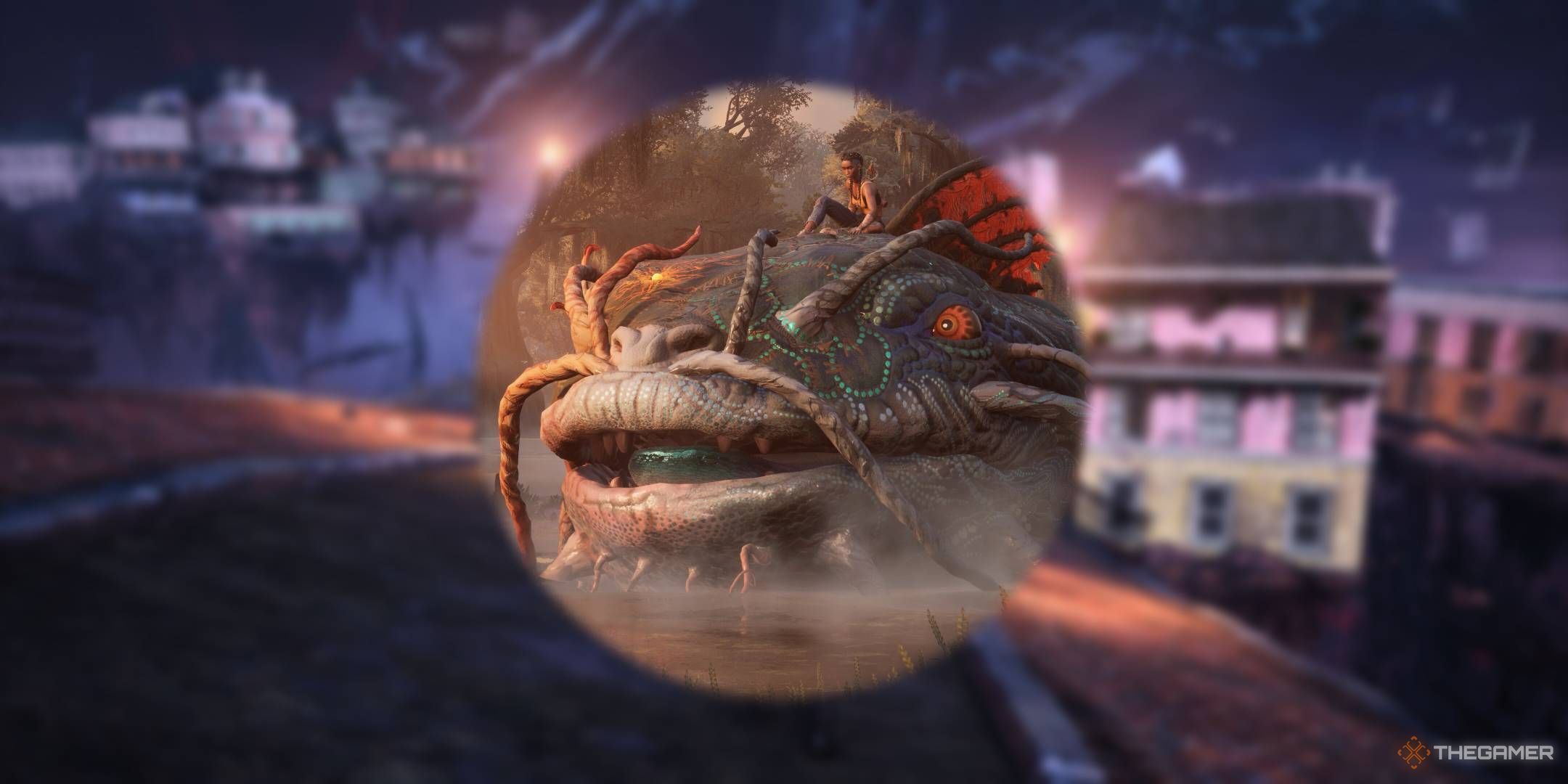
South of Midnight is a unique game for plenty of reasons - its stop-motion animation style, its return to a PS2-era style action-platormer combo - but what makes it stand out the most is its dedication to injecting Southern folklore and themes into every aspect of the game.
Related8 Best 3D Platformers On PS2
From iconic classics to forgotten gems, the PS2 had no shortage of great 3D platformers.
PostsAs we follow Hazel through the 14 chapters of South of Midnight, the Southern Gothic story will take us to multiple locations from its fictionalized amalgamation of the American Deep South. These areas are packed with references to the Deep South's folklore, some of which are so obscure that even lifelong residents of the region might not pick up on them. So what are they?
Spoilers Ahead!
The World Of South Of Midnight
CloseEvery design choice in South of Midnight has been influenced by the choice to set the game in the Deep South. While the areas you explore are not based on one particular town, city, or even state, Compulsion Games aimed to instead condense the most iconic aspects of different regions within the Deep South to create Prospero, a space that epitomizes the culture to create an authentic-feeling Southern Gothic Fantasy.
Specific areas that were lent from include different swamps, the Appalachians, and the end of the game will have Hazel exploring a dream-like abandoned city inspired by New Orleans.
While it doesn't originate in folklore, even the choice for Hazel's magical powers to be based on weaving is a clear reference as well. Lace and weaving are a core design motif in Southern Gothic stories and folklore, and Hazel's Weaver abilities represent this with her magical strands mimicking lace patterns. Embroidery can even be seen woven into specific textures the game uses.
Hazel's second costume that she wears for the middle portion of the game (a gift from her grandmother Bunny, who also seems to use Weaver powers as well) heavily features lace on the upper half of the bodice. This outfit of Hazel's seems to be the one Compulsion wants to promote most as representative of the game's image, with Hazel wearing it for the longest time out of the three outfits and it being used in the South of Midnight's key art.
Common themes in Southern folklore include overcoming the darkness that frightens you, something that Hazel finds herself doing again and again. A more specific narrative motif you'll find in Southern Gothic fiction is exploring old abandoned houses and learning the history that they hold as a framing device. This is particularly present in Chapters 7 and 9, where Hazel explores old towns to learn about the history of Laurant and Itchy, respectively.
Bottle Trees
A core design motif of South of Midnight that perfectly represents its roots in Deep South folklore are bottle trees. You'll first discover one of these bottle trees in the third chapter, so Hazel can use one of its bottles to capture, and literally bottle up, the negative energy and stigma that plagues certain residents of Prospero.
Bottle Trees are so synonymous with South of Midnight that a silhouette of a bottle tree is used in the game's logo.
Glass bottle trees have been created for centuries, and their first known origin is in the Congo in West Africa all the way back in the 9th Century, a tradition that was brought over to the Deep South as part of the slave trade.
They were created originally as a practice of Hoodoo (not to be confused with Voodoo) to capture nocturnal mischievous spirits. These spirits would usually cause trouble in the night, and they might even enter your house and wreak havoc. However, they are enamoured by the sparkling glass bottles and end up getting trapped inside. By the time morning comes, the sun would destroy them while they're still stuck in the bottle.
If you were unsure if the sun had destroyed the spirit inside the bottle, you could cork it and then throw it into a lake or river, since these evil spirits hate water as much as they hate sunlight.
While this tale is not adapted one-to-one in South of Midnight, the way Hazel uses a bottle from one of these trees to trap negative energy feels reminiscent of the tradition.
Creatures And Cryptids
As a Deep Southern Gothic tale, South of Midnight leans hard into magical realism, with Hazel's hometown of Prospero being victim to an onslaught of supernatural folkloric creatures following a flood. While the design of South of Midnight is a great way to see the Deep South roots of Compulsion's game, its most recognizable faces are in the creatures and cryptids that it stars.
Haints
If you're not from the Deep South, there's a good chance that you might think that Haint is just an original term that Compulsion came up with as an umbrella for all of its villainous spirits. However, Haint is not an original word, and originates from the Gullah people as an alternative pronunciation of haunt, used to describe ghosts or witch-like creatures.
Haints have been described to chase their victims to the point that they would die from exhaustion. While none of the normal Haints in South of Midnight do this, Hazel is chased by Kooshma's Hunger repeatedly throughout the story, and the choice to make Hazel a track athlete might also have been a conscious choice to align with this aspect of Haints.
In an effort to dissuade these spirits from entering their house, people used to paint their doors and even ceilings a specific shade of light blue to confuse the spirits into thinking that the painted surface is actually water and to avoid it. This painting choice became so popular that a shade of paint was named Haint Blue.
Giant Catfish
Unlike a lot of the other creatures that appear in South of Midnight, the giant talking catfish that regularly aids Hazel, simply known as Catfish, is not based on one particular folkloric tale or myth and is instead inspired by multiple urban legends.
RelatedBest Platformer Games Of All Time
The platformer is one of the oldest and most beloved genres of all time. If you're a fan of them, these are the titles you NEED to play.
Posts 2Rumours of giant catfish have been localized around the Tennessee River in particular for centuries. In Mark Twain's memoir from 1883, he even specifically mentions witnessing a 250-pound catfish, which, for reference, would have been 107 pounds heavier than the current record for an officially recognized caught catfish. Tales of giant catfish are so popular south of the Mason-Dixie that they're sometimes seen as the equivalent of the Loch Ness for the region.
Interestingly, legends of giant catfish are not exclusive to the Deep South, and a popular Japanese folktale explains that a giant mystical catfish called Namazu causes earthquakes when it swims. This tale of Namazu also happens to be the inspiration for the third-generation Pokémon, Whiscash.
Benjy And Cherie Tree
CloseLike Catfish, both Benjy and Cherie Tree are not inspired by one specific folkloric creature, and are instead inspired by common narrative motifs from Southern folklore.
Benjy is the spirit of a boy who was cruelly trapped by his brother inside a hollow tree and was pitied by the spirits as he cried for someone to help him. As he died, he merged with the tree and became part of it. Bunny, Hazel's grandmother, heard of this tale and carved part of Benjy's body and used it to help bond her deceased daughter Cherie into a tree in a similar vein to help keep her alive in some small way.
Even though Benjy and Cherie are not authentic folkloric characters in particular, they are inspired by a common narrative device of trees being resting spots and homes to wayward spirits. Whether they are supernatural creatures or the spirits of the deceased, you'll often hear tales of spirits bound to trees in Southern folklore, but as a common theme in other cultures as well.
Two-Toed Tom
Throughout the fifth chapter of South of Midnight, we learn that the giant alligator that's lurking around the flooded farm, known as Two-Toed Tom, was once owned by Jolene's abusive father. The man not only abused his daughter but also starved his alligator as well. In a successful attempt at revenge, Jolene fed her father to the alligator. Once freed, he went on to eat immeasurable amounts of farm animals to grow to the giant size he is during the game.
Two-Toed Tom is by no means a game original character, and he's based on a legendary alligator by the same name, rumoured to be local to the swamps of Florida and Alabama.
The gator's name originates from the myth that Tom had lost all but two of his toes to a steel trap.
Tom is also known more simply as just Two-Toe or Red-Eye, and he was known to eat mainly livestock, but depending on how gorey the tale was, even humans, too. The tales of Two-Toed Tom go as far back as the 1920s, and there are multiple stories of failed attempts to kill the beast. The mysterious gator grew so famous that there was even a festival in his honor held in Florida between 1987 and 2019.
Rougarou
Perhaps one of the most well-known folkloric creatures presented in South of Midnight, the Rougarou is a werewolf-like being most popular within the Cajun diaspora. As you might be able to tell based on its spelling, the one aspect that links most cultures that tell tales of the Rougarou is their francophone origins.
Legends tell of the Rougarou prowling swamps around the Greater New Orleans region, and it is usually described as being a mix of a human body with either the head of a wolf or sometimes a dog. A popular tale about the Rougarou told by Catholics is that it hunts and kills those who do not follow the rules of Lent.
This is the creature that Compulsion's designers took the most liberty with, choosing to take more inspiration from owls, but it works to fantastic effect, with the beast being as stunning as it is threatening. Laurant, a man who we learn ages incredibly slowly, was transformed into a Rougarou after witnessing the traumatic killing of his father when he was just a boy.
Huggin' Molly
Huggin' Molly, another one of the more popular creatures adapted in South of Midnight, also follows the path of the Rougarou by having a more creative adaptation.
The 'real' story of Huggin' Molly is used as a warning to children, mainly in and around Alabama, of a ghostly woman who wears a dark dress and brimmed hat, who, if she sees children out after dark, will grab and scream at them. The origins of Huggin' Molly vary on how sympathetically they portray the haunting woman.
Related10 Popular Video Game Urban Legends
From the believable to the ridiculous, video games aren't immune to being the subject of urban legends.
PostsSome paint her as the grieving mother of a child lost too soon who was driven mad by the grief and now lurks around at night to try and keep other children safe in an attempt to deal with her sorrow. However, others present her as a more vengeful spirit of a woman who was murdered, looking out for children to stop them from facing a similar fate. Something that binds these presentations is that she looks out for kids, in spite of being scary.
South of Midnight chooses to take the more sympathetic route. Even though Molly is shown to be a giant-spider/woman hybrid and is originally believed to have kidnapped and even killed Hazel's mother, Lacey, it's revealed after the fight against her that she was actually working with Lacey to heal children who have been forgotten by the system.
Honey Island Swamp Monster And Ayotunde (Altamaha-ha)
The eleventh chapter of South of Midnight focuses on the stories of the Honey Island Swamp Monster as well as a mermaid-like creature called Ayotunde. Unlike in the game, they don't share a story in Deep South folklore and are both separate characters from different tales.
The Honey Island Swamp Monster is sometimes known as the Cajun Sasquatch and is described as being a humanoid cryptid, similar to Bigfoot, that, as the name implies, inhabits the Honey Island Swamp in Louisiana. Its popularity is so widespread that there are tour companies that attempt to follow its trail. Unlike the more charming childlike appearance it's given in South of Midnight, the 'real' Honey Island Swamp Monster is described to have grey hair and a disgusting smell.
The character of Ayotunde, on the other hand, is inspired by Altamha-ha, a mermaid-adjacent creature from Georgia folklore. It's described as inhabiting small streams near the Altamaha region it is named after. It's believed to have a body like a sturgeon, but with front flippers and swimming like a dolphin.
Kooshma
CloseThe primary antagonist of South of Midnight, Kooshma, is shown in-game to be the King of Nightmares and an entity who aims to consume the emotions of those who can't move on from the past, in opposition to Hazel, who, as a Weaver, tries to heal these people.
Roux, a character who isn't directly based on any particular folkloric character, is a morally gray helper of Kooshmas. Thanks to his association with the crossroads in Chapter 12, he could be seen as aligned with a Deep Southern representation of the devil.
Alternatively spelled as Cauchemar, Kooshma is a more mysterious figure from Cajun folklore, who, unlike in South of Midnight, is usually presented as female. She's described as invading your dreams and holding you down while you sleep. Like some other folkloric creatures from the region, it occasionally overlaps with Catholicism and is described there as a punishment for sinning.
If any of this sounds familiar, it's because Kooshma is largely now believed to be a character used to explain sleep paralysis, the phenomenon of waking up but being unable to move your body. Multiple characters have popped up throughout history all around the world as a personification of this often terrifying phenomenon. Even in artwork, you'll see paintings of people with demons or evil spirits sitting on their stomachs, holding them down.
If you find yourself being afflicted by Kooshma/sleep paralysis in real life, avoid sleeping on your back, and if you wake up unable to move, focus on small movements at the tip of your toes, fingers, or, most effectively, scrunching your nose.
Your Rating
close 10 stars 9 stars 8 stars 7 stars 6 stars 5 stars 4 stars 3 stars 2 stars 1 star Rate Now 0/10Your comment has not been saved
Like Follow FollowedSouth of Midnight
Action Adventure Systems 3.5/5 8.0/10 Released April 8, 2025 ESRB rp Developer(s) Compulsion Games Publisher(s) Xbox Game Studios Engine Unreal Engine 5WHERE TO PLAY
SUBSCRIPTION












